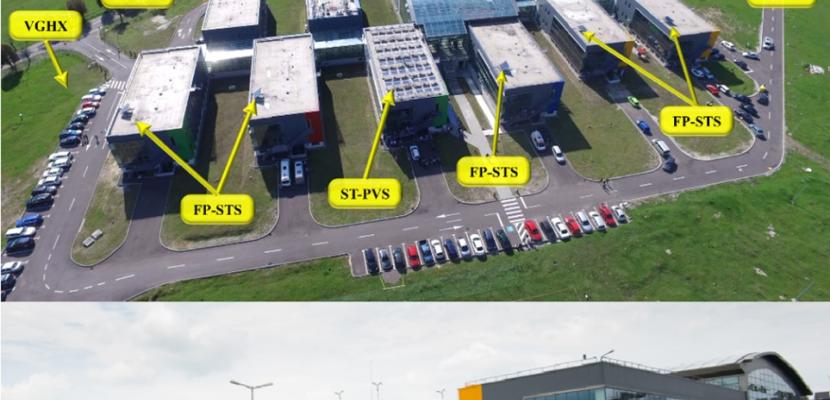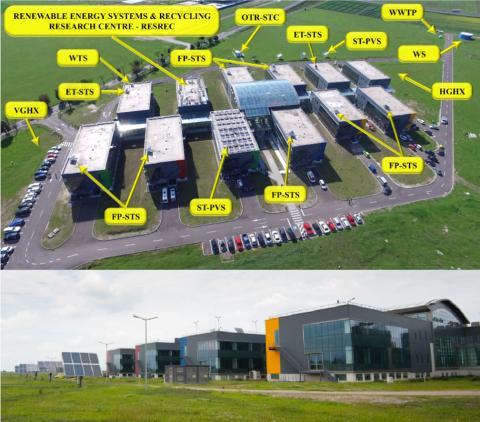
Energy efficientcy in university building complex - R&D institute of the Transilvania University from Brașov

About this good practice
The added infrastructure consists of energy and indoor air quality monitoring systems, renewable-based thermal energy systems with ground-coupled 22 kW heat pumps that extract the geothermal energy through vertical geothermal heat exchanger (VGHX) with four boreholes at a depth of 90 m each and horizontal geothermal heat exchangers (HGHX) of 1000 sqm mounted at 2.5 m depth, below the ground surface, and solar thermal systems (STS) with flat plate (FP) and evacuated tube (ET) collectors that deliver the thermal energy for DHW water preparation.
Moreover, grid-connected solar-tracking photovoltaic systems (ST-PVS) with a total installed power of 27 kWp are installed to yearly balance the electrical energy demand of the heat pumps along with the indoor lighting while standalone wind turbine systems (WTS) with a total installed power of 2.7 kW are delivering electrical energy for the outdoor lighting.
An outdoor testing rig was developed to investigate the facade integration of novel flat plate solar thermal collectors (OTR-STC) with trapeze and triangle shapes and various colours of the absorber plate.
The water is supplied from a local, 120-m-deep well (WS), and the wastewater is cleaned in a local wastewater treatment plant (WWTP) before discharge.
The institute infrastructure was developed through the project RTD Institute High Tech Products for Sustainable Development, PRO-DD and various RD projects at national and international level.
Resources needed
The R&D Institute was developed through the Structural Funds project “Research, Development and Innovation Institute: High-Tech Products for Sustainable Development, PRO-DD”, financed by POS-CCE, ID123, SMIS 2637, Contract 11/2009 (~14 mil. €) and by Transilvania University of Brasov (~6 mil. €).
Evidence of success
The energy consumption is monitored for each building. The yearly thermal energy demand is 66.7 kWh/m2 and the yearly electrical energy demand is 9.8 kWh/m2 with a yearly of 76.7 kWh/m2, validating their low energy building status.
The RES mix provides yearly 60021 kWh/year of thermal energy by the geothermal heat pumps and solar thermal, and 29557 kWh/year mainly by the PV systems and wind turbines. 86.8% of the yearly energy demand comes from on-site RES making the building a nZEB Building.
Potential for learning or transfer
The energy efficiency solutions and the renewable based energy mix implemented in the R&D Institute may inspire public authorities to develop similar energy efficient infrastructures, to mitigate the use of fossil fuels and GHG emissions through the use of RES and to improve public policy in the field of sustainable development.
The R&D Institute of the Transilvania University was developed to significantly contribute to the regional, national and international effort for developing new, feasible, market and socially accepted results on Sustainable Development.
The Institute supports joint cooperation in integrated topics, according to the regional, national and international priority topics:
-joint development of high level research;
-research and innovation services, quality certification, design and projects development;
-education in research oriented study programmes at M.Sc. and Ph. D. levels;
-training on advanced topics based on existing hardware/software resources
Further information
S3UNICA - Universitatea Transilvania din Brașov
Images


Documents
SIMULATION MODEL IN TRNSYS OF A SOLAR HOUSE FROM BRASOV ROMANIA.pdf
Website
Good practice owner
You can contact the good practice owner below for more detailed information.